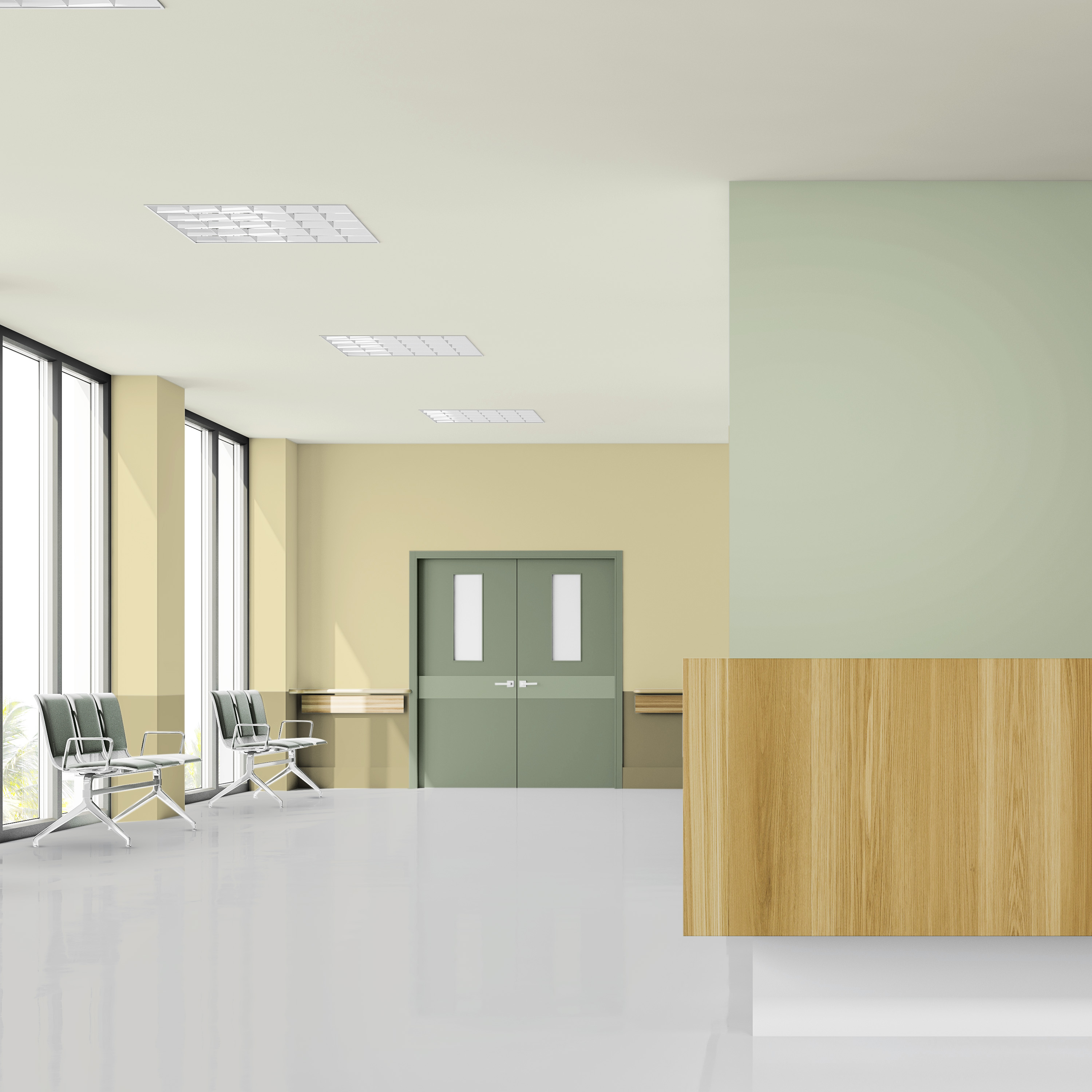When specifying paint for healthcare environments, it is important to get the right balance between aesthetic appeal and practical requirements, such as hygiene, durability, and sustainability. Here, Andrew Cleaver, National Sector Manager for Healthcare at Dulux Decorator Centre, shares his advice on how to navigate the complexities of paint specification in this sector.
Making the right paint selection
Healthcare environments can be incredibly busy, welcoming high numbers of staff and visitors every day. To stand up to this high traffic and constant wear and tear, it is important to select highly durable paints like Dulux Trade Scuffshield Matt. This paint is known for its exceptional scuff resistance, making it ideal for high-traffic areas such as corridors, entranceways, and waiting rooms. Its cleanable matt finish also offers good stain resistance, ensuring the professional finish lasts longer.
However, for areas that need additional protection against the spread of bacteria and viruses – such as hospital wards – specialist paints may be required. Products like Dulux Trade Sterishield Dual Active Matt that feature in-film antimicrobial additives will help to inhibit the growth of bacteria like MRSA and E. coli, as well as viruses including Coronaviruses and Human Herpesvirus*. Combined with regular cleaning, this paint helps to maintain a hygienic environment. It also boasts a tough, scrubbable, and stain-resistant finish, making it a long-lasting solution that is suitable for all standard interior wall and ceiling surfaces.
To maintain any painted surface, use mild soap, warm water, and a soft sponge to remove any marks or scuffs. Gloss or semi-gloss finishes, which are commonly used on trim, are particularly easy to clean due to their smooth surface, which resists dust and adhesion.
Strategic Colour Selection
As well as the type of paint, it is also crucial to think about colour. The colours used should reflect the room's purpose and the desired emotional response of its occupants. For instance, calming colours like pale blues, soft greens, and pastel lilacs are ideal for bedrooms and waiting areas as they help people to feel relaxed. Conversely, more saturated colours or vibrant hues like yellows and oranges may be better suited to spaces that are designed for activities, such as play areas in children's wards or spaces for rehabilitation.
Before committing to a colour scheme, it is vital to test paint samples in the intended space first. This is because the perception of a colour can change significantly under different lighting conditions.
Enhancing Sustainability
There are several strategies that can be employed to help reduce the environmental impact of redecoration projects. Firstly, paints and coatings play a key role in preserving buildings and protecting surfaces, but regular redecoration can increase carbon emissions and costs over a building’s lifetime. Opting for long-lasting, durable solutions will therefore help to extend maintenance cycles and improve sustainability.
To reduce emissions further, it is important to select water-based paints. To help with the application and drying processes, paints and coatings contain volatile organic compounds (VOCs). These are chemical vapours and are found in higher quantities in solvent-based paints – and, as the paint is used, the chemical vapours are released into the air. VOCs contribute to the formation of greenhouse gases in the atmosphere and add to ground level pollution and global warming. They can also negatively impact indoor air quality.
Opting for low VOC, water-based solutions is therefore key. Thanks to innovations in paint technology, there are now products on the market that are 99.9% VOC free - such as Dulux Trade Diamond Matt, which delivers outstanding durability, as well as sustainability benefits.
To improve sustainability further, it is important to consider the paint’s packaging. Once paint cans are empty, it is important to responsibly dispose of them. Dulux Decorator Centre offers a free can recycling scheme that allows customers to return clean, empty paint cans in store or as part of a scheduled delivery. The cans are processed and recycled into new products, contributing to a circular economy and reducing waste.
However, for larger projects, traditional 10L paint cans might not be the best solution. Dulux Decorator Centre now offers a selection of products in 170L containers, which can be cleaned and refilled to minimise packaging waste. If they are used twice or more, the bulk units become a more sustainable packing solution than the 10L packs.
Navigating the complexities of paint specification in healthcare environments requires a careful balance between aesthetic appeal and practical requirements. By following these guidelines, healthcare environments can achieve a harmonious blend of functionality, aesthetics, and sustainability in their paint specifications. For further advice on specifying paint for healthcare settings, or to explore more sustainable solutions, visit Dulux Decorator Centre’s Specification Hub: www.duluxdecoratorcentre.co.uk/paint-specification
* Tested against certain types of bacteria and viruses:
· Tested to ISO 22196 with over 99% less viable E. coli and MRSA left after 2 hours when compared to a control (Sterishield Diamond Matt).
· Tested to ISO 21702 with:
. over 58 % less viable Feline coronavirus left after 1 hour compared to a control (Sterishield Diamond Matt),
. over 41 % less viable Human herpes virus HHV-1 left after 1 hour compared to a control (Sterishield Diamond Matt),
. over 76 % less viable Human coronavirus SARS-CoV-2 left after 1 hour compared to a control (Sterishield Diamond Matt).












